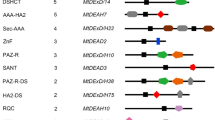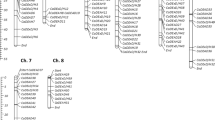Abstract
Helicases are motor proteins which can catalyze the unwinding of stable RNA or DNA duplex utilizing mainly ATP as source of energy. In this study we have identified complete sets of helicases from rice and Arabidopsis. The helicase gene family in rice and Arabidopsis contains 115 and 113 genes respectively. These helicases were validated based on their annotations and supported with organization of conserved helicase signature motifs. We have also identified homologs of 64 rice RNA and DNA helicases in Arabidopsis, yeast and human. We explored Arabidopsis oligonucleotide array data to gain functional insights into the transcriptome of helicase family members under ten different stress conditions. Our results revealed that expression of helicase genes is profoundly regulated under various stress conditions. The helicases identified in this study lay a foundation for the in depth characterization of each helicase type.






Similar content being viewed by others
References
Arabidopsis Genome Initiative (2000) Analysis of the genome sequence of the flowering plant Arabidopsis thaliana. Nature 408:796–815
Arnold K, Bordoli L, Kopp J, Schwede T (2006) The SWISS-MODEL Workspace: a web-based environment for protein structure homology modelling. Bioinformatics 22:195–201
Aubourg S, Kreis M, Lecharny A (1999) The DEAD-box RNA helicase family in Arabidopsis thaliana. Nucleic Acids Res 27:628–636
Bennetzen J (2002) The rice genome. Opening the door to comparative plant biology. Science 296:60–63
Bernstein DA, Zittel MC, Keck JL (2003) High-resolution structure of the E. coli RecQ helicase catalytic core. EMBO J 22:4910–4921
Boudet N, Aubourg S, Toffano-Nioche C, Kreis M, Lecharny A (2001) Evolution of intron/exon structure of DEAD helicase family genes in Arabidopsis, Caenorhabditis, and Drosophila. Genome Res 11:2101–2114
Brewster AS, Wang G, Yu X, Greenleaf WB, Carazo JM, Tjajadia M, Klein MG, Chen XS (2008) Crystal structure of a near-full-length archaeal MCM: functional insights for an AAA+ hexameric helicase. Proc Natl Acad Sci USA 105:20191–20196
Cho WK, Geimer S, Meurer J (2009) Cluster analysis and comparison of various chloroplast transcriptomes and genes in Arabidopsis thaliana. DNA Res 16:31–44
Cordin O, Banroques J, Tanner NK, Linder P (2006) The DEAD-box protein family of RNA helicases. Gene 367:17–37
Dalmay T, Horsefield R, Braunstein TH, Baulcombe DC (2001) SDE3 encodes an RNA helicase required for post-transcriptional gene silencing in Arabidopsis. EMBO J 20:2069–2077
de la Cruz J, Kressler D, Linder P (1999) Unwinding RNA in Saccharomyces cerevisiae: DEAD-box proteins and related families. Trends Biochem Sci 24:192–198
Eisen MB, Spellman PT, Brown PO, Botstein D (1998) Cluster analysis and display of genome-wide expression patterns. Proc Natl Acad Sci USA 95:14863–14868
Finn RD, Tate J, Mistry J, Coggill PC, Sammut JS, Hotz HR, Ceric G, Forslund K, Eddy SR, Sonnhammer EL, Bateman A (2008) The Pfam protein families database. Nucleic Acids Res 36:D281–D288
Goff SA, Ricke D, Lan TH, Presting G, Wang R et al (2002) A draft sequence of the rice genome (Oryza sativa L. ssp. japonica). Science 296:92–100
Gong Z, Lee H, Xiong L, Jagendorf A, Stevenson B, Zhu JK (2002) RNA helicase-like protein as an early regulator of transcription factors for plant chilling and freezing tolerance. Proc Natl Acad Sci USA 99:11507–11512
Gong Z, Dong CH, Lee H, Zhu J, Xiong L, Gong D, Stevenson B, Zhu JK (2005) A DEAD-box RNA helicase is essential for mRNA export and important for development and stress responses in Arabidopsis. Plant Cell 17:256–267
Gorbalenya AE, Koonin EV (1993) Helicases: amino acid sequence comparisons and structure-function relationship. Curr Opin Struct Biol 3:419–429
Hartung F, Plchova H, Puchta H (2000) Molecular characterization of RecQ homologues in Arabidopsis thaliana. Nucleic Acids Res 28:4275–4282
Holding DR, Springer PS (2002) The Arabidopsis gene PROLIFERA is required for proper cytokinesis during seed development. Planta 214:373–382
Hruz T, Laule O, Szabo G, Wessendorp F, Bleuler S, Oertle L, Widmayer P, Gruissem W, Zimmermann P (2008) Genevestigator v3: a reference expression database for the meta-analysis of transcriptomes. Adv Bioinform 420747
Jankowsky E, Fairman ME (2007) RNA helicases–one fold for many functions. Curr Opin Struct Biol 17:316–324
Kant P, Kant S, Gordon M, Shaked R, Barak S (2007) STRS1 and STRS2, two DEAD-box RNA helicases that attenuate Arabidopsis responses to multiple abiotic stress. Plant Physiol 145:814–830
Kim JS, Kim KA, Oh TR, Park CM, Kang H (2008) Functional characterization of DEAD-box RNA helicases in Arabidopsis thaliana under abiotic stress conditions. Plant Cell Physiol 49:1563–1571
Kobbe D, Blanck S, Demand K, Focke M, Puchta H (2008) AtRECQ2, a RecQ helicase homologue from Arabidopsis thaliana, is able to disrupt various recombinogenic DNA structures in vitro. Plant J 55:397–405
Kobbe D, Blanck S, Focke M, Puchta H (2009) Biochemical characterization of AtRECQ3 reveals significant differences relative to other RecQ helicases. Plant Physiol 151:1658–1666
Kumar S, Dudley J, Nei M, Tamura K (2008) MEGA: a biologist-centric software for evolutionary analysis of DNA and protein sequences. Brief Bioinform 9:299–306
Linder P (2006) Dead-box proteins: a family affair—active and passive players in RNP-remodeling. Nucleic Acids Res 34:4168–4180
Linder P, Owttrim GW (2009) Plant RNA helicases: linking aberrant and silencing RNA. Trends Plant Sci 14:344–352
Liu HH, Liu J, Fan SL, Song MZ, Han XL, Liu F, Shen FF (2008) Molecular cloning and characterization of a salinity stress-induced gene encoding DEAD-box helicase from the halophyte Apocynum venetum. J Exp Bot 59:633–644
Liu Y, Richards TA, Aves SJ (2009) Ancient diversification of eukaryotic MCM DNA replication proteins. MBC Evol Biol 9:60
Lorsch JR (2002) RNA chaperones exist and DEAD-box proteins get a life. Cell 109:797–800
Mahajan S, Tuteja N (2005) Cold, salinity and drought stresses: an overview. Arch Biochem Biophys 444:139–158
Neuwald AF, Aravind L, Spouge JL, Koonin EV (1999) AAA+: a class of chaperon-like ATPases associated with the assembly, operation, and disassembly of protein complexes. Genome Res 9:27–43
Ouyang S, Zhu W, Hamilton J, Lin H, Campbell M, Childs K, Thibaud-Nissen F, Malek RL, Lee Y, Zheng L, Orvis J, Haas B, Wortman J, Buell CR (2007) The TIGR rice genome annotation resource: improvements and new features. Nucleic Acids Res 35:D883–D887
Owttrim GW (2006) RNA helicases and abiotic stress. Nucleic Acids Res 34:3220–3230
Park W, Li J, Song R, Messing J, Chen X (2002) CARPEL FACTORY, a dicer homolog, and HEN1, a novel protein, act in microRNA metabolism in Arabidopsis thaliana. Curr Biol 12:1484–1495
Pause A, Methot N, Sonenberg N (1993) The HRIGRXXR region of the DEAD box RNA helicase eukaryotic translation initiation factor 4A is required for RNA binding and ATP hydrolysis. Mol Cell Biol 13:6789–6798
Pennacchio LA (2003) Insights from human/mouse genome comparisons. Mamm Genome 14:429–436
Pettersen EF, Goddard TD, Huang CC, Couch GS, Greenblatt DM, Meng EC, Ferrin TE (2004) UCSF chimera—a visualization system for exploratory research and analysis. J Comput Chem 25:1605–1612
Pike ACW, Shrestha B, Popuri V, Burgess-Brown Muzzolini L, Costantini S, Vindigni A, Gileadi O (2009) Structure of the human RECQ1 helicase reveals a putative strand-separation pin. Proc Natl Acad Sci USA 106:1039–1044
Poole RL (2007) The TAIR database. Methods Mol Biol 406:179–212
Sabelli PA, Burgess SR, Kush AK, Young MR, Shewry PR (1996) cDNA cloning and characterization of a maize homologue of the MCM proteins required for the initiation of DNA replication. Mol Gen Genet 252:125–136
Saitou N, Nei M (1987) The neighbor-joining method: a new method for reconstructing phylogenetic trees. Mol Biol Evol 4:406–425
Sanan-Mishra N, Pham XH, Sopory SK, Tuteja N (2005) Pea DNA helicase 45 over expression in tobacco confers high salinity tolerance without affecting yield. Proc Natl Acad Sci USA 102:509–514
Schmid SR, Linder P (1992) D-E-A-D protein family of putative RNA helicases. Mol Microbiol 6:283–291
Schneider TD, Stephens RM (1990) Sequence logos: a new way to display consensus sequences. Nucleic Acids Res 18:6097–6100
Schuster-Böckler B, Schultz J, Rahmann S (2004) HMM Logos for visualization of protein families. BMC Bioinformatics 5:7
Shultz RW, Lee T-J, Allen GC, Thompson WF, Hanley-Bowdoin L (2009) Dynamic localization of the DNA replication proteins MCM5 and MCM7 in plants. Plant Physiol 150:658–669
Soukas A, Cohen P, Socci ND, Friedman JM (2000) Leptin-specific patterns of gene expression in white adipose tissue. Genes Dev 15:963–980
Springer PS, McCombie WR, Sundaresan V, Martienssen RA (1995) Gene trap tagging of PROLIFERA an essential MCM2–3-5-like gene in Arabidopsis. Science 268:877–880
Springer PS, Holding DR, Groover A, Yordan C, Martienssen RA (2000) The essential Mcm7 protein PROLIFERA is localized to the nucleus of dividing cells during the G(1) phase and is required maternally for early Arabidopsis development. Development 127:1815–1822
Sturn A, Quackenbush J, Trajanoski Z (2002) Genesis: cluster analysis of microarray data. Bioinformatics 18:207–208
Tanner NK, Linder P (2001) DExD/H box RNA helicases: from generic motors to specific dissociation functions. Mol Cell 8:251–262
Tuteja N (2003) Plant DNA helicases, the long unwinding road. J Exp Bot 54:2201–2214
Tuteja R (2010) Genome wide identification of Plasmodium falciparum helicases: a comparison with human host. Cell Cycle 9:104–120
Tuteja N, Tuteja R (2004a) Prokaryotic and eukaryotic DNA helicases. Essential molecular motor proteins for cellular machinery. Eur J Biochem 271:1835–1848
Tuteja N, Tuteja R (2004b) Unravelling DNA helicases. Motif, structure, mechanism and function. Eur J Biochem 271:1849–1863
Ursic D, Himmel KL, Gurley KA, Webb F, Culbertson MR (1997) The yeast SEN1 gene is required for the processing of diverse RNA classes. Nucleic Acids Res 25:4778–4785
Vashisht AA, Tuteja N (2005) Cold stress-induced pea DNA helicase 47 is homologous to eIF4A and inhibited by DNA-interacting ligands. Arch Biochem Biophys 440:79–90
Vashisht AA, Tuteja N (2006) Stress responsive DEAD-box helicases, a new pathway to engineer plant stress tolerance. J Photochem Photobiol B 84:150–160
Vashisht AA, Pradhan A, Tuteja R, Tuteja N (2005) Cold and salinity stress-induced bipolar pea DNA helicase 47 is involved in protein synthesis and stimulated by phosphorylation with protein kinase C. Plant J 44:76–87
Vincentz M, Cara FA, Okura VK, da Silva FR, Pedrosa GL et al (2004) Evaluation of monocot and eudicot divergence using the sugarcane transcriptome. Plant Physiol 134:951–959
Yu J, Hu S, Wang J, Wong GK, Li S et al (2002) A draft sequence of the rice genome (Oryza sativa L. ssp. indica). Science 296:79–92
Yu J, Wang J, Lin W, Li S, Li H et al (2005) The genomes of Oryza sativa. A history of duplications. PLoS Biol 3:266–281
Acknowledgments
Work on helicases and plant stress tolerance in N.T.’s laboratory is supported partially by the Department of Science and Technology (DST), Government of India and Department of Biotechnology (DBT), Government of India.
Author information
Authors and Affiliations
Corresponding author
Electronic supplementary material
Below is the link to the electronic supplementary material.
Rights and permissions
About this article
Cite this article
Umate, P., Tuteja, R. & Tuteja, N. Genome-wide analysis of helicase gene family from rice and Arabidopsis: a comparison with yeast and human. Plant Mol Biol 73, 449–465 (2010). https://doi.org/10.1007/s11103-010-9632-5
Received:
Accepted:
Published:
Issue Date:
DOI: https://doi.org/10.1007/s11103-010-9632-5




